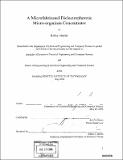| dc.contributor.advisor | Joel Voldman. | en_US |
| dc.contributor.author | Muller, Rikky, 1980- | en_US |
| dc.contributor.other | Massachusetts Institute of Technology. Dept. of Electrical Engineering and Computer Science. | en_US |
| dc.date.accessioned | 2005-09-26T20:12:32Z | |
| dc.date.available | 2005-09-26T20:12:32Z | |
| dc.date.issued | 2004 | en_US |
| dc.identifier.uri | http://hdl.handle.net/1721.1/28393 | |
| dc.description | Thesis (M. Eng. and S.B.)--Massachusetts Institute of Technology, Dept. of Electrical Engineering and Computer Science, June 2004. | en_US |
| dc.description | "May 2004." | en_US |
| dc.description | Includes bibliographical references (leaves 83-85). | en_US |
| dc.description.abstract | This project focuses on the development of a micro-organism concentrator. Pathogen detection, particularly MEMS based detection, is often limited by sample concentration. The proposed concentrator will interface with a pathogen detector. This type of pathogen concentrator can be useful for many kinds of applications including water purification systems, medical applications and biological warfare agent detection. Due to the nature of these applications, the concentrator must be able to operate under real-world conditions, and be robust to particulates and variations in solution conductivity. The concentrator is an active filter, which concentrate bacteria in solution using negative dielectrophoresis, which pushes objects away from the electrodes toward field minima. An electric field barrier is set up to guide cells toward a concentrated outlet flow path while the bulk of the fluid, which permeates the electric field barrier, is sent to a waste outlet. The cells are collected at the outlet and selectively released by turning off the applied voltage. I have fully designed and modeled the characteristics of the proposed concentrator and successfully fabricated the design. I have characterized the system throughput using polystyrene beads and I have characterized the system electrically using lumped circuit element models. | en_US |
| dc.description.statementofresponsibility | by Rikky Muller. | en_US |
| dc.format.extent | 85 leaves | en_US |
| dc.format.extent | 5487837 bytes | |
| dc.format.extent | 5497210 bytes | |
| dc.format.mimetype | application/pdf | |
| dc.format.mimetype | application/pdf | |
| dc.language.iso | en_US | |
| dc.publisher | Massachusetts Institute of Technology | en_US |
| dc.rights | M.I.T. theses are protected by copyright. They may be viewed from this source for any purpose, but reproduction or distribution in any format is prohibited without written permission. See provided URL for inquiries about permission. | en_US |
| dc.rights.uri | http://dspace.mit.edu/handle/1721.1/7582 | |
| dc.subject | Electrical Engineering and Computer Science. | en_US |
| dc.title | A microfabricated dielectrophoretic micro-organism concentrator | en_US |
| dc.type | Thesis | en_US |
| dc.description.degree | M.Eng.and S.B. | en_US |
| dc.contributor.department | Massachusetts Institute of Technology. Department of Electrical Engineering and Computer Science | |
| dc.identifier.oclc | 56978461 | en_US |
